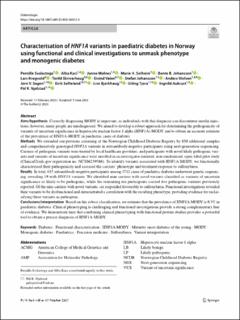| dc.description.abstract | Aims/hypothesis
Correctly diagnosing MODY is important, as individuals with this diagnosis can discontinue insulin injections; however, many people are misdiagnosed. We aimed to develop a robust approach for determining the pathogenicity of variants of uncertain significance in hepatocyte nuclear factor-1 alpha (HNF1A)-MODY and to obtain an accurate estimate of the prevalence of HNF1A-MODY in paediatric cases of diabetes.
Methods
We extended our previous screening of the Norwegian Childhood Diabetes Registry by 830 additional samples and comprehensively genotyped HNF1A variants in autoantibody-negative participants using next-generation sequencing. Carriers of pathogenic variants were treated by local healthcare providers, and participants with novel likely pathogenic variants and variants of uncertain significance were enrolled in an investigator-initiated, non-randomised, open-label pilot study (ClinicalTrials.gov registration no. NCT04239586). To identify variants associated with HNF1A-MODY, we functionally characterised their pathogenicity and assessed the carriers’ phenotype and treatment response to sulfonylurea.
Results
In total, 615 autoantibody-negative participants among 4712 cases of paediatric diabetes underwent genetic sequencing, revealing 19 with HNF1A variants. We identified nine carriers with novel variants classified as variants of uncertain significance or likely to be pathogenic, while the remaining ten participants carried five pathogenic variants previously reported. Of the nine carriers with novel variants, six responded favourably to sulfonylurea. Functional investigations revealed their variants to be dysfunctional and demonstrated a correlation with the resulting phenotype, providing evidence for reclassifying these variants as pathogenic.
Conclusions/interpretation
Based on this robust classification, we estimate that the prevalence of HNF1A-MODY is 0.3% in paediatric diabetes. Clinical phenotyping is challenging and functional investigations provide a strong complementary line of evidence. We demonstrate here that combining clinical phenotyping with functional protein studies provides a powerful tool to obtain a precise diagnosis of HNF1A-MODY. | en_US |

